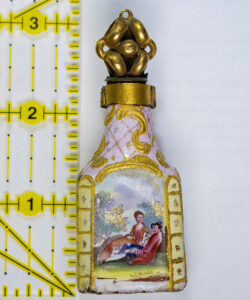 SR sent me this pink and blue gold gilded porcelain bottle with an ornate gold stopper and interesting “scoop” or funnel to the top in metal. She called it a MOURNING BOTTLE, a gift from Sir Benjamin Rycroft (1902-1967), a pioneer in corneal surgery, and one of the most influential ophthalmologists of the past century, to his daughter in law. SR is a relative of Sir Benjamin, who was responsible for the restoration of sight of hundreds of WWII veterans. He also pioneered organ donation. How fitting that Sir Benjamin gave his new daughter-in-law a tear-catcher! The theory went that a lady cried into the funnel held to the nose, saved the tears, and when the tears evaporated, they declared mourning OVER….
SR sent me this pink and blue gold gilded porcelain bottle with an ornate gold stopper and interesting “scoop” or funnel to the top in metal. She called it a MOURNING BOTTLE, a gift from Sir Benjamin Rycroft (1902-1967), a pioneer in corneal surgery, and one of the most influential ophthalmologists of the past century, to his daughter in law. SR is a relative of Sir Benjamin, who was responsible for the restoration of sight of hundreds of WWII veterans. He also pioneered organ donation. How fitting that Sir Benjamin gave his new daughter-in-law a tear-catcher! The theory went that a lady cried into the funnel held to the nose, saved the tears, and when the tears evaporated, they declared mourning OVER….
The Tear Catcher Problem
Did this custom exist in the early to mid-19th century or did it emerge as a modern myth developed by “Tear Catcher Gifts” years ago? Evidence exists of these little bottles in ancient times. Occasionally they ARE called tear-catchers by museums, or tear jars, or lachrymatories. Museum of Wigan Life in Leigh, England, included a small glass bottle, called a tear jar, from AD 30 found in Egypt in their exhibit “Ancient Egypt Rediscovered,” focusing on life and death rituals. Scholars of European scent and ritual Nuri McBride writes “Victorian Tear Catchers are TRASH.” She believes they’re more likely European rose-water bottles if porcelain with spouts for pouring, or “throwaway” glass perfume sample vials if long and narrow and English.
SR’s bottle is NOT glass, and too small for a rosewater bottle. I’m skeptical a woman brought out this bottle when mourning. The bright colors and flashy gilding used to catch the tears of a early to mid-19th century mourner doesn’t add up. An English lady in mourning in the 19th century wore black matte crepe fabrics with NO SHEEN, and only dark muted jewelry such as of jet, bog oak, or vulcanite. A French lady, if she lost her husband, wore black, gray, or violet for eighteen months, did not raise her voice above a whisper, ate alone, and took few visitors. So if SR’s fancy bottle would be acceptable to a lady, or her society, if she were expected to be in deep black mourning.
My Tear Catcher Theory
My theory is that SR’s bottle isn’t exactly a mourning bottle but a HOPEFUL bottle, used to catch tears of longing for a distant sweetheart, perhaps at war. Plenty of wars happened in France in the second quarter of the 19th century, whereupon I date this bottle. This explains the sentimental courting couples pictured and the bright pinks and blues and golds.
In ancient times, notably in the Middle East, they saw tears as hallmarks of care. A saying says the Divine will never let a tear go unnoticed. In David’s prayer (Psalm 56:8), he said, “You keep track of all my sorrows. You have collected all my tears into your bottle. You have recorded each one in your book.” In fact we DO read records of tomb discoveries of small bottles for tears, meant to show honor and devotion to the dead. But by the 19th century, even though we read of these mourning bottles in fiction, we find little evidence, only examples of the MANY porcelain and glass bottles to hold perfumes, smelling salts, floral waters, scented vinegars, “kumkums” (of Middle east exotic florals), or unguentium (for unguents).
Because of the Provenance
Still, one of the world’s foremost eye doctors gave this gift. I doubt Sir Benjamin Rycroft mixed up sources for such a bottle. We do find Civil War mentions of wives and sweethearts collecting tears for the presentation of the same bottle upon a soldier’s return.
SR’s bottle appears Continental, however. As Nuri McBride, the perfume scholar, writes: maybe these mythic mourning bottles are “just a metaphor for measuring immeasurable loss.” I believe SR’s is indeed a tear collection bottle, because of the provenance. But I think it a tear bottle filled for a soldier fighting far afield, and a ritual to mark the time of longing. This ‘matches’ the sentimentality of the mid-19th century nicely, exhibited as a public performance.